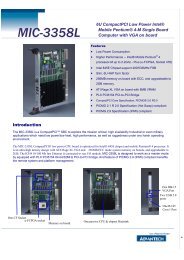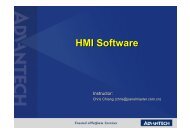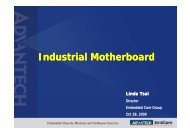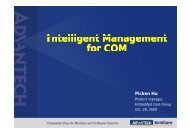industrial wireless book special edition - Networking ...
industrial wireless book special edition - Networking ...
industrial wireless book special edition - Networking ...
Create successful ePaper yourself
Turn your PDF publications into a flip-book with our unique Google optimized e-Paper software.
Wireless avoids cable trouble on<br />
electroplating line automation<br />
Easily damaged and maintenance prone trailing cables on the<br />
suspended monorail of a plastic part electroplating line have been<br />
eliminated through the combined use of an <strong>industrial</strong> <strong>wireless</strong> LAN,<br />
Profisafe and an extension of IEEE 802.11 through iPCF. Christof<br />
Kreienmeier explains.<br />
ELECTROPLATING SPECIALIST, BIA Kunststoffund<br />
Galvanotechnik GmbH of Solingen, Germany<br />
has, together with Aucos Elektronische Geräte<br />
GmbH of Aachen, planned, built and commissioned<br />
a new electroplating production line.<br />
Unusually, the suspended monorail tracks above<br />
the electroplating tanks are not powered via<br />
trailing or armoured wire cables, but communicate<br />
with the control system using Profisafe<br />
via <strong>wireless</strong> LAN (WLAN).<br />
This approach was chosen because cables<br />
collect contamination and dust particles that<br />
end up in the tanks, and because the everincreasing<br />
speeds of the trolleys (typically up<br />
to 120m/min) result in cable breaks. The<br />
resulting production losses can be very<br />
expensive. BIA suggested replacing the trailing<br />
cables with the only viable alternative – a<br />
radio-based <strong>industrial</strong> solution that had to be<br />
capable of providing cyclic and time-critical<br />
data traffic at predictable transfer rates. This<br />
would ensure reliable emergency stop circuit<br />
functioning.<br />
Industrial Point Coordinated Function – speed equates to safety<br />
In safety technology, the primary issue is transferring safety signals as quickly as possible to the control<br />
to head off critical situations. It is therefore necessary to assign the available bandwidth clearly, and<br />
to afford safety signals the highest priority. Siemens implements this by extending the IEEE 802.11<br />
standard with the Industrial Point Coordinated Function (iPCF) a transmission protocol that – in contrast<br />
to the DCF method – governs access by multiple participants to the <strong>wireless</strong> network deterministically.<br />
IPCF is a proprietary process that supports roaming in a WLAN infrastructure at times of 50ms. Both<br />
AP and client must support rapid roaming. In automation technology, it is often necessary to transfer<br />
process data and alarms in real time. Existing DCF and PCF roaming procedures don’t allow such realtime<br />
data transfer without interruption.<br />
iPCF is based on the centralised PCF procedure, already described in the first WLAN standard IEEE<br />
802.11 in 1999. With PCF, the AP polls the connected stations and assigns time slices for data<br />
transmission. In contrast, iPCF works with a proprietary modified data frame protocol structure, so that<br />
iPCF clients can log on to an AP on which iPCF is enabled. The AP therefore becomes the ultimate<br />
authority and assigns transmission times to clients as time slices. This produces stable and predictable<br />
response times (typically 16ms with five to eight clients) with intensive use of the available bandwidth<br />
capacity in the radio network. For this reason, iPCF is very suitable for typical production fieldbuses<br />
that achieve their real-time behaviour through short cycle times.<br />
sponsored by Advantech<br />
<strong>industrial</strong> ethernet <strong>book</strong><br />
Controlled <strong>wireless</strong> field<br />
Siemens supplied the <strong>wireless</strong> automation<br />
technology, which included rapid-roamingenabled<br />
IP65-protected <strong>industrial</strong> access points<br />
(APs), plus leaky feeder cables (Fig. 1) to<br />
provide a controlled radio field along the tracks.<br />
Aucos chose a failsafe controller that also<br />
operates the Profinet system connection to<br />
Aucos’ control system. The controller connects<br />
to a managed switch having eight electrical ports<br />
that communicates with four <strong>industrial</strong> WLAN<br />
rapid roaming APs (IEEE 802.11-compliant)<br />
distributed in the field. These do not set up a<br />
typical omni-directional <strong>wireless</strong> network in free<br />
space, but use the <strong>special</strong> leaky feeder cables to<br />
create a uniform field strength along the four<br />
tracks that can be reliably monitored.<br />
Their counterpart in each suspended monorail<br />
trolley is the directional transmitting and<br />
receiving antenna situated alongside the leaky<br />
feeder cable to allow optimal communication.<br />
In the trolley vehicle switch box, each antenna<br />
is connected to a WLAN device used as a<br />
gateway between WLAN and Profibus,<br />
forwarding the relevant Profibus and safety<br />
signals. Failsafe signal modules, motor starters<br />
and frequency converters for the suspended<br />
monorail trolleys completed the Siemens<br />
supplied equipment.<br />
Despite the advanced automation technology,<br />
plastics electroplating still needs much manual<br />
intervention, so there are no barrier fences.<br />
Ensuring operator safety at all times depends<br />
on the reliability of the Profisafe communication<br />
components, as well as a clear prioritisation<br />
of safety signals.<br />
In a fixed installation, the rapid roaming APs<br />
support the free movement of several nodes in<br />
the <strong>wireless</strong> network and can transfer them<br />
seamlessly from one AP to another. This mobile<br />
installation uses rapid roaming to ensure high<br />
signal transmission speed to and from the<br />
trolleys using the extended iPCF protocol (see<br />
box). It therefore ensures that the safetyrelevant<br />
data is transmitted to the controller<br />
with a cycle time of only 16ms, allowing<br />
predictable response times well below 100ms<br />
– more than sufficient for time-critical<br />
emergency-stop decisions. In addition, process<br />
times can be controlled very precisely.<br />
Fig. 1. With their IP65 enclosures the access points are<br />
installed freely in the field and connected directly to the<br />
RCoax leaky feeder cable (blue).<br />
Interference-free<br />
The leaky feeder cable provides safety in a very<br />
different way. Aucos installed it parallel to the<br />
suspended monorails in strands of around 50m,<br />
ensuring that the field strength along the line<br />
provides reliability. Because the radio field is<br />
directional, it offers optimum reception, even<br />
with significantly reduced field strength. As a<br />
result, electromagnetic exposure is reduced –<br />
and only a few meters away, the radio network<br />
is practically too weak for external users to<br />
receive it. Advanced encryption algorithms<br />
mean that there is effective protection against<br />
unauthorised access.<br />
The decision to use the 5GHz band was made<br />
to avoid interference caused by <strong>wireless</strong><br />
sensors, Bluetooth devices and other devices<br />
that operate in the more common 2.4GHz band.<br />
The <strong>wireless</strong> components use both frequencies<br />
as standard.<br />
BIA is satisfied and says that in future, new<br />
systems will always be equipped with this<br />
WLAN solution, being found to be far superior<br />
to the maintenance-prone trailing cable. It is<br />
quieter, a better system overview is now<br />
possible and the transport trolleys have<br />
virtually unlimited route options. One<br />
unplanned downtime can easily cost several<br />
thousand euros, but this system has eliminated<br />
cable breakages.<br />
Christof Kreienmeier works for Siemens AG’s Industry<br />
Sector – Industry Automation in Düsseldorf, Germany.<br />
First published in the <strong>industrial</strong> ethernet <strong>book</strong> July 2011<br />
PHOTO: SIEMENS<br />
Case Study<br />
53

















